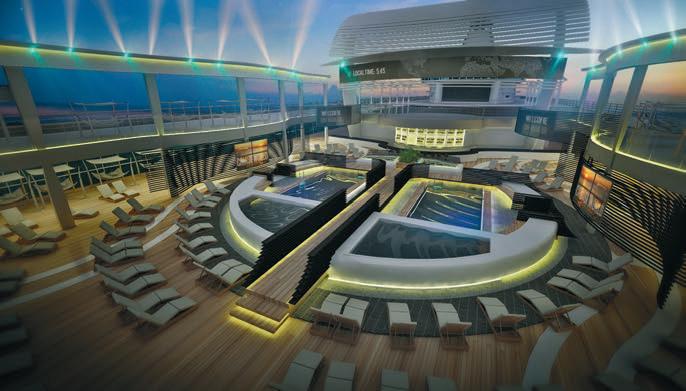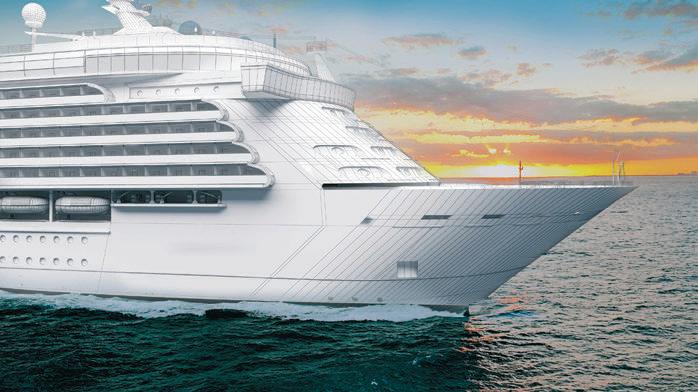
5 minute read
BIM on the high seas?
Matthew Jensen of architecture and interiors consultancy Fraiserline explores the challenges of applying BIM to cruise and ferry ship design, to serve the complex needs of architectural, interior, product and naval professionals.
During the late 1800s, the crea- by parametric modelling validated by the tion of passenger ships began, OEM, cruise and ferry interior designers with similar attributes to luxu- rarely incorporate parametric modelling ry buildings all designed to the and most operate only 2D CAD systems. grandeur of neo-classical architecture. The architects and design teams were pri- Architecture meets shipbuilding marily naval specialists, but adopted the At Fraiserline, our roots are in architecture, ornamentation of buildings within the but we have merged this expertise with interiors of passenger ships. The process shipbuilding and developed a niche for the would have incorporated interior design of cruise hand drawn blueprints, liner ships. Since 2016 we’ve starting with a concept helped innovate new passendirection, then technical ger liner fleets across varidetail drawings for interior ous operator brands. fit-out during shipbuilding. During this process we’ve
The introduction of CAD continually explored the transformed the approach, important question of can changing the duties for BIM be expanded to cruise design teams going forward. and ferry ship design, and Information technology also can the boundaries of the allowed design teams to digitally coordinate drawing files with shipbuilding yards and ‘‘ The fusion software be pushed beyond buildings? Our biggest challenge as a fit-out contractors. By having between business has been working overlays for each specific dis- parametric alongside the carrier to cipline, the shipbuilding specialists were able to quickly appraise the construction of a product design software and appoint a suitable digital design system for efficient collaboration and teampassenger liner in great parametric work coordination, specifidetail. This is similar to the architectural cally to the cruise-ship and approach taken in building design, where architect, intesoftware needs marine engineering industry. The initial investigation rior designer, engineer and a middle- demonstrated that marine project manager are appoint- ground, that engineering companies ed. However, marine timescales and regulations are highly stringent. would re-shape the way that were working on a wide range of specialist design tools, ranging from 2D CAD
The spatial arrangement of large passenger to the latest versions of 3D modern liner fleets is set by ships are built parametric systems. standards of the operator, including ship types and specifications for the ship’s own infrastrucRecently, I was told by an industry contact that Royal Caribbean International has started to ’’ ture and systems. Cruise operators usually incorporate BIM into the corporate shipnominate a shipyard which can provide a building department. Whilst the overall standard OEM or catalogue of typical pas- naval attributes may prove difficult to senger ship structures. Unlike aircraft incorporate into BIM, the building-like cabin and rail carriage design, undertaken elements of passenger ships could be introduced into the BIM environment.
Typically, tools such as SolidWorks have been used for masterplanning naval architecture and provided better features than 2D CAD. In addition, the coordination of specialist teams needs improvement and almost welcomes the collaborative advantages of BIM – to automate, improve and streamline the design-to-delivery process.
Siemens PLM has gone a step further and developed a specialist software, utilised by companies such as Daewoo Shipping, Hyundai Heavy Industries and Sunseeker International. The system includes a number of specific features such as ship structural analysis, material data, mechanical and engineer tools and other comprehensive tool sets. This, however, when looking at a large marine project such as a cruise liner in the context of a building, does not provide a teamwork platform that can be friendly to all disciplines throughout the whole build process.
Applying Revit to marine projects Recently, Fraiserline began moving its core architectural design projects onto BIM at Stage 02 in order to ease efficiency and productivity within the office. This was a prime opportunity to test the capabilities of Autodesk Revit to see if it had any merit for the cruise industry.
Having recently undertaken refurbishment contracts for global superliners, we have found that many design teams supply project data as SolidWorks or IGES files. In some cases we have received a point cloud internal survey.
With our idea to pilot Revit for a superliner refit, the import of SolidWorks files has proven successful, and can be cleanly organised by Revit “families” in a similar practice to managing the import of point cloud data files.
Whilst most attributes of parametric CAD/CAM files are not fully editable or transparent they can be referenced to rep-
resent another team’s design elements efficiently within the BIM environment. This has given our designers a quicker and clearer understanding of the proposal in three-dimensions and allows us to parametrically model a solution in realtime for sign-off and approval, and in some cases undertake quick CGI simulation visuals.
The confidence in pushing BIM to nonbuilding related projects has been taxing and frustrating at most times as a small business. Whilst trying to migrate various parametric model formats supplied by other parties, improvising tools has been near-impossible for non-standard components in BIM, such as the creation of watertight bulkhead doors specific to marine regulatory requirements.
Secondly, a ship structure being primarily steelwork can link to the superstructure orders of Revit, but does not validate the ship performance standards, structural assessment or construction methods that differ from typical building systems as per the current defaults of BIM.
The overall mantra of BIM is appropriately relevant for the cruise-ship design sector, allowing architects, designers, engineers and professionals to collaborate and coordinate efficiently and effectively. The programmed building vocabularies within the software could be adapted for cruise-ship megastructures and could correlate with other engineering software systems with ease. However, the end result has still proven to be commercially beneficial when comparing against former practices by using 2D CAD software.
Conclusion The fusion between parametric product design software and parametric architectural software needs a middle-ground, that would re-shape the way that large passenger ships are built. In addition, the latest BIM and parametric design software includes metadata capabilities that link to materials and specifications in order to provide a live inventory of production information.
Within the marine industry itself, the technological innovations with ship systems including navigation equipment, power generation, propulsion and autopilot have automated the bridge to “sail by wire” as similar to the aviation industry. Contrary to the current design process, the benefits of introducing BIM to the marine market would innovate the future of shipbuilding, yet could provide the opportunity for a new software tool specific to this type of industry.
The question remains - what will be the future with the creation of new superliners, and what design tools will be introduced, if not BIM, to improve the future delivery of marine project in specific focus to the multi-disciplinary requirements with the cruise and ferry industry?


1 Superliner cruise ship 2 Passenger deck visualisation 3 Passenger ship Revit model









